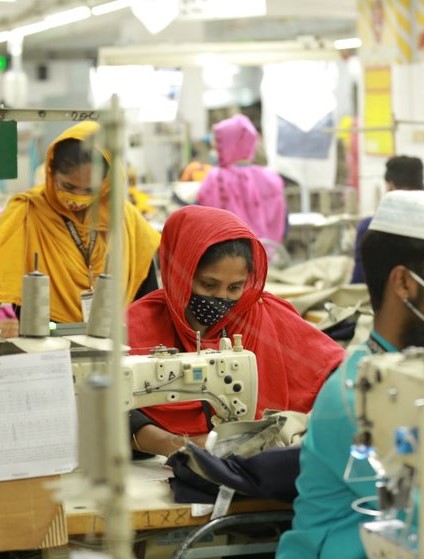Authors: Md Abdullah Al Shakil and Afrida Maroof
“In the meeting room at a BRAC regional office, Rafsan apa was watching a video on the wide screen along with her fellow garment workers with wild disbelief. She couldn’t believe that a machine was sewing a shirt that she sews with her own hands!!”
As the global ready-made garment industry is going through a transition period of shifting from industry 3.0 to industry 4.0, the wind of that change is touching Bangladesh, one of the top competitors in the global market, as well. The apparel sector in Bangladesh is heavily dependent on its human resources, more than half of which are women. The question that one needs to ask standing at this moment of transition is, that if these women RMG workers, who run the wheels of the industry as well as this country know what this means for them and how they perceive this transformation.
In an attempt to answer this question, a study has been conducted by BRAC Social Innovation Lab and BRAC Advocacy Unit where more than 50 women ready-made garment workers talked about their perception of automation and industry 4.0 via interviews and focus group discussions. The study intended to find out the extent of understanding that these women workers possess on automation and AI and their thoughts on the future of their work.
The response received from these women is quite alarming in a way because most of these women cannot perceive the idea of them being replaced by a machine. Assumedly, with the slow transition to automation, many garment workers, especially women workers, will lose their job. Why are women at a bigger risk of losing jobs? Most of the study participants work in the factories as workers and sewing machine operators and the kind of work their roles entail will potentially be redundant as technology develops. However, the majority of them are unaware of this situation and how it is going to impact their future. The reasons behind this limited knowledge can be looked at from two perspectives:
1) Perception and belief of the female garment workers: Most women workers are not very concerned about their slow career growth. As per the study, workers who could learn to run one or more machines and got promoted to the position of operators are quite confident about their future. It is widely believed among these women that the swing operators are the most skilled laborers and they have fewer chances to lose their job. And if new machines come, they will learn to operate it. It is hard for them to believe that sewing skills can be replaced by a robot.
2) Internalized gender perception in the industry: While the number of women is higher in the industry, the majority of them are stuck at the bottom level positions in the industry. They can seldom make it to a role beyond the post of operators and these are the jobs that are about to be obsolete with the rise of industry 4.0. Why is this disparity? There seems to be an internalized sexism in the system itself which is not often realized by the women workers themselves. They do not see this disparity in the number of women in leadership positions as a problem. Not being able to climb up the career ladder seems pretty normal to them as they think women are less educated, and are not fit for leadership roles owing to multiple factors such as household responsibilities, working over hours with minimal security etc.
This lack of leadership roles does not only hinder women from achieving according to their capacity, but also limits their knowledge of looming risks and adversities in the industry. Their ignorance about automation and potential job loss is a testimony of that. This status quo is scary because this paradigm shift is inevitable but the fate of the workers who have been the biggest contributor to this industry remain uncertain as Bangladesh inches towards this transition.
What can be the way forward? Information is the key to understanding. Women workers need to see the imminent threat that they are facing, for them to believe it and to actively work for escaping it. Skills development, training programs can be some of the solutions that can be offered to pull them out of unskilled positions and help them move forward.
Women garment workers must realize that they can be equally good at leadership roles. In order to create a work environment free of gender bias, it is important that both the workers and the industry authorities work on breaking the glass ceiling together. Only then Rafsan apa and her coworkers will have a fair opportunity at changing the tide of their fate that industry 4.0 is bringing closer.
- 936 views
- 0 comments


